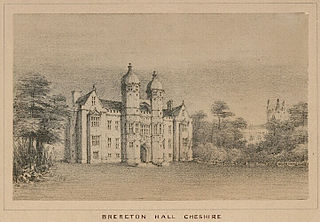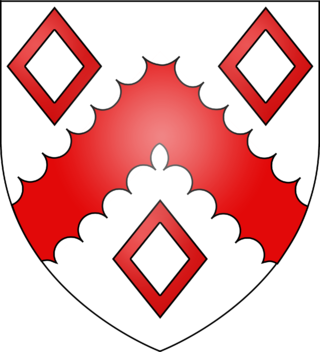
Earl of Bradford, of Bradford in the County of Salop, is a title that has been created twice, once in the Peerage of England and once in the Peerage of the United Kingdom. It was first created in 1694 for Francis Newport, 2nd Baron Newport. However, all the Newport titles became extinct on the death of the fourth Earl in 1762. The earldom was revived in 1815 for Orlando Bridgeman, 2nd Baron Bradford. The Bridgeman family had previously succeeded to the Newport estates.
Baron Ravensworth, of Ravensworth Castle in the County Palatine of Durham and of Eslington Park in the County of Northumberland, is a title in the Peerage of the United Kingdom.
William Widdrington, 1st Baron Widdrington was an English landowner and politician who sat in the House of Commons from 1640 to 1642 and was created a peer in 1643. He fought in the Royalist army in the English Civil War and was killed in battle in 1651.

Baron Brereton, of Leighlin in the County of Carlow, was a title in the Peerage of Ireland. It was created on 11 May 1624 for Sir William Brereton, of Brereton, Cheshire.
Baron Hawley, of Donsmore, was a title in the Peerage of Ireland. It was created on 8 July 1646 for Sir Francis Hawley, 1st Baronet, a supporter of Charles I. He had already been created a baronet, of Buckland in the County of Somerset, in the Baronetage of England in 1644. He was succeeded by his grandson, also Francis, who served as Member of Parliament for Bramber, Sussex between 1713 and 1715. The latter's son, Francis, the third Baron, was Governor of Antigua. The titles became extinct on the death of the fourth Baron in 1790.

Viscount Hewett was a title in the Peerage of Ireland. It was created on 9 April 1689 for Sir George Hewett, 2nd Baronet. He was made Baron of Jamestown at the same time, also in the Peerage of Ireland. The Hewett Baronetcy, of Pishiobury in the County of Hertford, was created in the Baronetage of England on 19 July 1660 for Thomas Hewett, Member of Parliament for Windsor. Both titles became extinct on the first Viscount's death in 1689.
Ralph Widdrington was one of the eight sons of William Widdrington, 1st Baron Widdrington and his wife, Mary.

There have been twenty one baronetcies created for persons with the surname Williams, eight in the Baronetage of England, three in the Baronetage of Great Britain and ten in the Baronetage of the United Kingdom. Only six of the creations are extant as of 2017.
There have been two baronetcies created for persons with the surname Williamson, one in the Baronetage of England and one in the Baronetage of the United Kingdom.
The Worsley family is an English family that is derived from Sir Elias de Workesley, a Norman knight who was a youth at the time of the Norman conquest. He later accompanied Duke Robert II of Normandy on the First Crusade and was buried at Rhodes.

There have been two baronetcies created for persons with the surname Yelverton, both in the Baronetage of England.
There have been two baronetcies created for people named Cole, one in the Baronetage of England and one in the Baronetage of Ireland.
The Bland Baronetcy, of Kippax Park in the County of York, was a title in the Baronetage of England. It was created on 30 August 1642 for Thomas Bland, of Kippax Park, near Leeds, Yorkshire, in honour of his father's service to King Charles I. The third Baronet succeeded his father as an infant, died at the age of five and was succeeded by his brother who was Member of Parliament for Appleby 1681 and for Pontefract 1698–1713. The fifth Baronet represented Lancashire 1713–27 and the sixth Baronet served as member for Ludgershall 1754–5. His brother succeeded in 1755 but died in 1756, at which time the baronetcy became extinct.

There have been three baronetcies created for members of the Widdrington family, one in the Baronetage of Nova Scotia and two in the Baronetage of England. All three creations are extinct. The Widdringtons were an ancient Northumbrian family who took their name from the village near Morpeth, Northumberland. In the 17th century the family were strongly Royalist and were rewarded with one baronetcy in the Baronetage of Nova Scotia and two in the Baronetage of England. William Widdrington was created a baronet, of Widdrington in the County of Northumberland, in the Baronetage of England on 9 July 1642. For more information on this creation, see Baron Widdrington. His cousin Edward Widdrington was created a Baronet, of Widdrington in the County of Northumberland, in the Baronetage of Nova Scotia on 26 September 1635, and a Baronet, of Cartington in the County of Northumberland, in the Baronetage of England, on 8 August 1642. The Nova Scotia baronetcy became either extinct or dormant on his death in 1671 while the English baronetcy became extinct.
Sir John Delaval, 3rd Baronet, was an English politician.

The Spring Baronetcy, of Pakenham in the County of Suffolk, is a title in the Baronetage of England.
There have been two baronetcies created in the Baronetage of England for members of the Colepeper family of Kent and Sussex. Both are extinct.

Sir Thomas Leigh was an English merchant and Lord Mayor of London in 1558-59. He served as a City Alderman from 1552 until 1571.
Maria (Mary) Winifreda Francisca Howard, Duchess of Norfolk was an English Catholic noblewoman, the last of the wealthy Shireburn family. She married twice, firstly to Thomas Howard, 8th Duke of Norfolk, from whom she became estranged before his death, and secondly to Peregrine Widdrington. She built a house in London on Arlington Street, which today is the clubhouse of the Royal Over-Seas League.
Commander Sir Henry Stapleton Mainwaring, 5th Baronet JP was an English soldier and actor.









